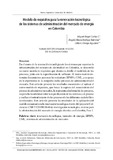Simulating current-energy converters: SNL-EFDC model development, verification, and parameter estimation

Share this
Author
James S.C.
Johnson E.L.
Barco J.
Roberts J.D.
Citación
Metadata
Show full item recordAbstract
Increasing interest in power production from ocean, tidal, and river currents has led to significant efforts to maximize energy conversion through optimal design and siting and to minimize effects on the environment. Turbine-based, current-energy-converter (CEC) technologies remove energy from current-driven systems and in the process generate distinct wakes, which can interact with other CEC devices and can alter flow regimes, sediment dynamics, and water quality. This work introduces Sandia National Laboratories-Environmental Fluid Dynamics Code CEC module and verifies it against a two-dimensional analytical solution for power generation and hydrodynamic response of flow through a CEC tidal fence. With a two-dimensional model that accurately reflects an analytical solution, the effort was extended to three-dimensional models of three different laboratory-flume experiments that measured the impacts of CEC devices on flow. Both flow and turbulence model parameters were then calibrated against wake characteristics and turbulence measurements. This is the first time that turbulence parameter values have been specified for CEC devices. Measurements and simulations compare favorably and demonstrate the utility and accuracy of this numerical approach for simulating the impacts of CEC devices on the flow field. The model can be extended to future siting and analyses of CEC arrays in complex domains. © 2017 Elsevier Ltd
Collections
- Indexados Scopus [1632]
Related items
Showing items related by title, author, creator and subject.
-
Non-Smooth Dynamics in Energy Market Models: A Complex Approximation from System Dynamics and Dynamical Systems Approach
Valencia-Calvo J.; Olivar-Tost G.; Morcillo-Bastidas J.D.; Franco-Cardona C.J.; Dyner I.This paper reports a general model that describes the supply and demand of electricity in a national market based on the system dynamics (SD) approach. From the resulting SD model, it derives piecewise smooth (non-smooth) ... -
Fault characterization and heat-transfer modeling to the Northwest of Nevado del Ruiz Volcano
Moreno D.; Lopez-Sanchez J.; Blessent D.; Raymond J. (Elsevier LtdIngeniería AmbientalFacultad de Ingenierías, 2018)The Nevado del Ruiz Volcano is an area of great interest for future geothermal exploitation in Colombia facing exploration challenges as hydrothermal fluids originate deep into the fractured basement. Fieldwork conducted ... -
Modelo de requisitos para la renovación tecnológica de los sistemas de administración del mercado de energía en Colombia
Cañas C., Miguel Angel; Bedoya Ramirez, Angela Maria; Urrego Agudelo, Lilliam (Universidad de MedellínFacultad de IngenieríasMedellín, 2016-06-30)

